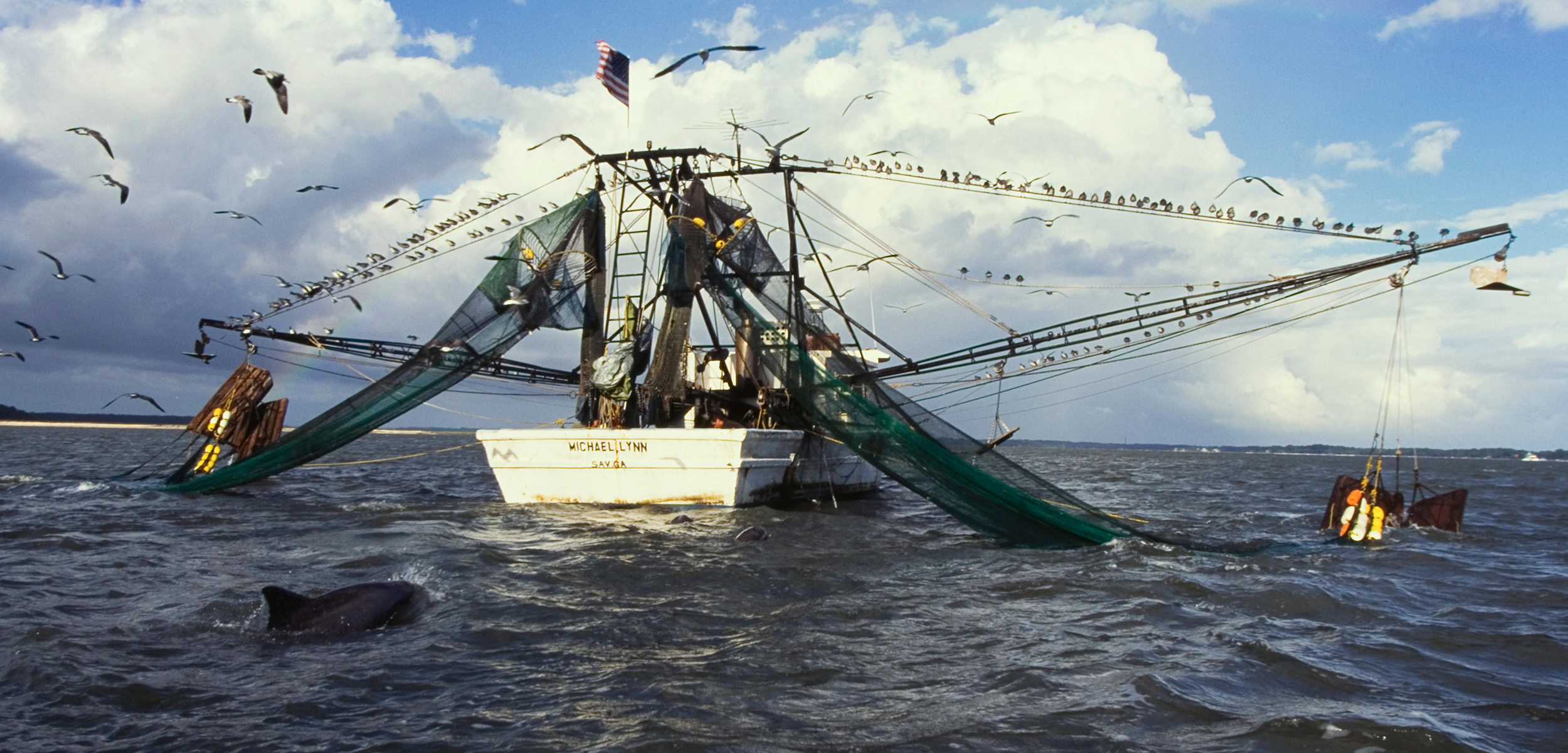Rich Dolphin, Poor Dolphin, Beggar Dolphin, Thief
Human activity turns dolphins into beggars and thieves. What does that mean for their social lives?
Article body copy
When we hear about the ways humans are affecting wild animals, it’s often in terms of numbers: populations, habitat area, or even fatalities. But off the coast of Savannah, Georgia, people are having a very different kind of influence: in response to human activity, local bottlenose dolphin populations are forming entirely new social groups.
The fertile fishing grounds off Georgia are popular with recreational boaters and shrimp trawlers. In addition to simply hunting for fish, some of the dolphins have learned to exploit these flotillas in two different ways: some beg for scraps of food alongside boats, and some follow shrimp trawlers, snapping up morsels that escape from the nets. Scientists have seen dolphins do both of these things before, but until now, the two behaviors hadn’t been studied together in the same population. By doing so, Robin Perrtree, a marine science technician at Savannah State University, has learned more about how dolphins adopt different feeding tactics, and how that affects their social organization.
“Although there are two different human-interaction behaviors, they have completely different social ramifications on the population,” says Perrtree.
Perrtree and her coauthors found that the trawler scavengers hang out together, and not just while they’re trailing shrimp boats. The trawler followers also don’t mix much with regular fish-hunting dolphins.
In contrast, beggars can be found hanging out with both trawler followers and hunters, but when they beg, they seem to operate solo. This makes sense, says Perrtree: if you are trying to deke around a big net, there’s plenty for everyone. But if you’re begging for a finite resource, say, one or two fish from a boat, your chances of a tasty morsel are greater if you go it alone.
A question that still remains is how the dolphins learned these methods of exploiting the largesse. When it comes to following trawlers, the question of which came first—the social clustering or the behavior—still isn’t clear. For example, did trawler dolphins bond over a common interest in the strategy, or did a pre-existing social group learn to raid trawlers?
Previous research in Australia’s Morton Bay, where trawler followers are also found, offers a clue. In the late 1990s, new legislation sharply reduced trawling in Morton Bay, and the tight-knit groups of trawler chasers disbanded. This reinforces the idea that trawler-following behavior created the social group, not the other way around.
As for the beggars, Perrtree says each dolphin may have learned the skill on its own.
Perrtree found that dolphins are relentless beggars once they take it up, and that begging is very difficult for them to unlearn even when the rewards stop coming. “Inconsistent, unpredictable, positive reinforcement is the best way to teach new skills,” she says. “It’s the reason why things like gambling are so addictive—it’s because you never know when that reward is coming.”
Hal Whitehead, a biologist at Dalhousie University who studies the social lives of whales and dolphins, says dolphins are well known for interacting with humans, so it’s not surprising that human activity along the coast is shaping their social groups. He says the long-term effects of this kind of social segregation aren’t known, but the short-term effects are clearer: the beggars and the thieves are facing very different risks.
“I’d be more concerned about begging,” says Whitehead. “When you’re begging, you may be fed stuff that’s not good, like junk food.” He says he’s heard stories of people trying to feed dolphins beer bottles. “Trawler discards aren’t too bad to eat.”
Aside from that, both beggars and thieves run the risk of getting hit by a ship’s propeller, while the thieves also risk entanglement in nets. But Whitehead says the beggars are particularly at risk: approaching boats opens them up to the range of humanity, and some people will want to hurt them.
Perrtree says the future effects aren’t clear, though feeding in different groups might eventually lead to different ecotypes developing within the population, such as those found in North Pacific killer whales. But long before those kinds of population-level effects appear, there are more immediate concerns, such as injury and food insecurity.
“Shrimp season is only open for approximately six months each year in Georgia,” she explains. The short window is a particular issue for young dolphins. “If their mothers are not teaching them sufficient natural foraging techniques, then they may not find enough prey when the shrimpers are not working.”
Perrtree has seen the consequences of the dolphins’ learned behaviors firsthand. The first summer the team headed out on the waves, they saw fishermen on a dock, home to several large trawlers, teasing dolphins with by-catch.
“It was like SeaWorld,” Perrtree recalls. “You came around the corner and saw dolphins tail-walking because the fishermen were holding up fish, taunting them.”
After several years of discussion with the trawler operators, Perrtree says many of the fishermen now toss by-catch away from dolphins and won’t reward begging. The biggest take-home, she says, is to keep wild animals wild—for their own good.

